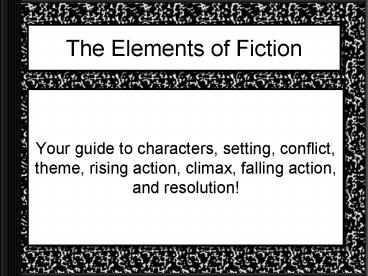The Elements of Fiction - PowerPoint PPT Presentation
1 / 22
Title: The Elements of Fiction
1
The Elements of Fiction
- Your guide to characters, setting, conflict,
theme, rising action, climax, falling action, and
resolution!
2
Characters
- People, animals or imaginary creatures that take
part in the action of the story. - There are two types of characters major and
minor.
3
Major Minor
- The story revolves around the events in the life
of one person, animal or creature. - Can be several major characters.
- Interacts with the main characters and other
minor characters. - They help provide a background for the story and
their actions help move the story along?
4
Character Traits
- All characters have traits. For example
- What do they look like?
- What is their personality like?
- What feelings do they have?
- What actions do they take?
- What are their motives?
5
Characters
- Compare and contrast
- When comparing characters, you describe what they
have in common. - When contrasting characters, you describe the
differences between them.
6
Setting
- The time and place of the story.
- Example the story takes place in Lawrence, KS
on KU campus in the year 1999. - Other examples in a land far, far away, or the
present day.
7
Setting
- Description is important to setting.
- What do the characters see?
- What do the characters hear?
- What do they smell? Taste? Touch?
8
Conflict
- Includes the plot (sequence of events)
- Is built around a problem a character needs to
solve. - There are three types of conflict.
9
Conflict
Character V. Character Character has a
problem w/another character.
Character V. Self Character is Struggling with
self.
Character V. Nature Character deals with nature
in some way.
Can you think of examples of each?
10
Conflict
- Cause and effect play an important role in
conflict. - Who or what caused the conflict?
- What effect does this have on the characters?
11
Rising Action
- The sequence of events that takes place before
the climax. - Includes introduction to characters, setting and
conflict.
12
Climax
- The point of highest interest in the story.
- Think of it as the high point of the whole
story. - Does NOT always fall in the middle of the story.
13
Falling Action
- The sequence of events that happen after the
climax.
14
Resolution
- Occurs at the end of the story.
- All loose ends are tied up and the story comes to
a close. - The conflicts are solved.
15
Theme
- The main message the author conveys to the
reader. - A general statement about a lesson, about life,
or a belief about people. - Examples Good will prevail over evil, or the
strong will survive.
16
Elements of Fiction
Climax
Falling Action
Rising Action
Resolution Theme
Setting Characters Conflict
17
Literary Elements
- Flashback
- Foreshadowing
- Symbolism
- Imagery
- Metaphor
18
Flashback
- When a writer stops the present action of a story
and tells about something that happened in the
past, it is called a flashback. - Used to provide readers with information to help
them understand the story - Be aware of flashback as you read
19
Foreshadowing
- Foreshadowing is the use of hints of clues to
suggest what will happen later in the story. - It builds suspense by raising questions that
encourage the reader to go on and find out more
about the event that is being foreshadowed.
20
Symbolism
- Symbolism is when a person, place or object
(which has a meaning in itself) suggests other
meanings. - Things, characters and actions can be symbols.
- Common symbols sunshine goodness, darkness
evil.
21
Imagery
- Imagery is language that appeals to the senses.
- Descriptions of people or objects are stated in
terms of our senses - what it looks like, sounds
like, smells like, feels like, tastes like. - Imagery helps paint a picture in your head as you
read.
22
Metaphor
- A metaphor is a comparison between two objects
where one thing is said to be another (does not
use like or as). - For example The road was a ribbon of moonlight.
Love is a red rose.































